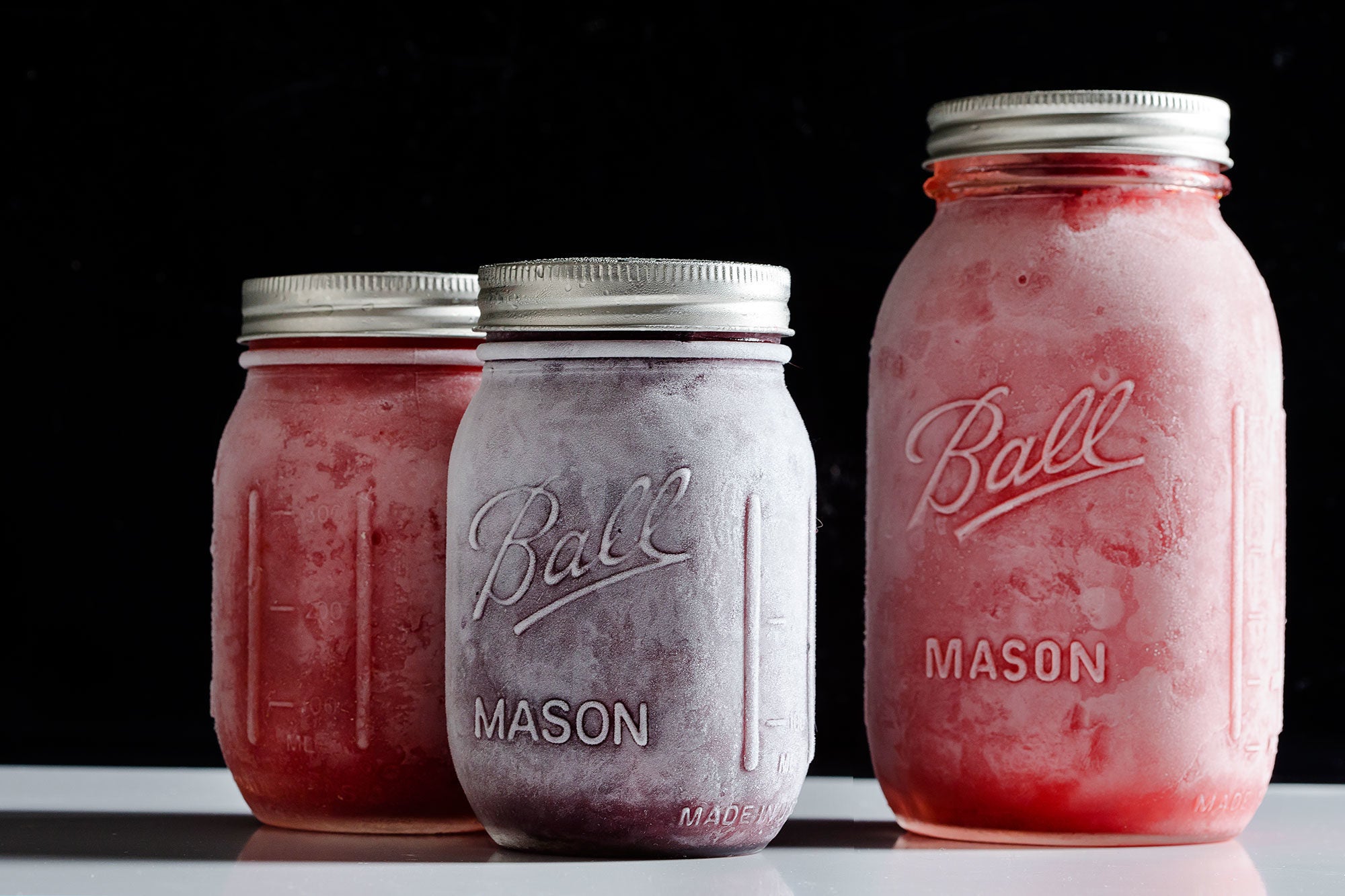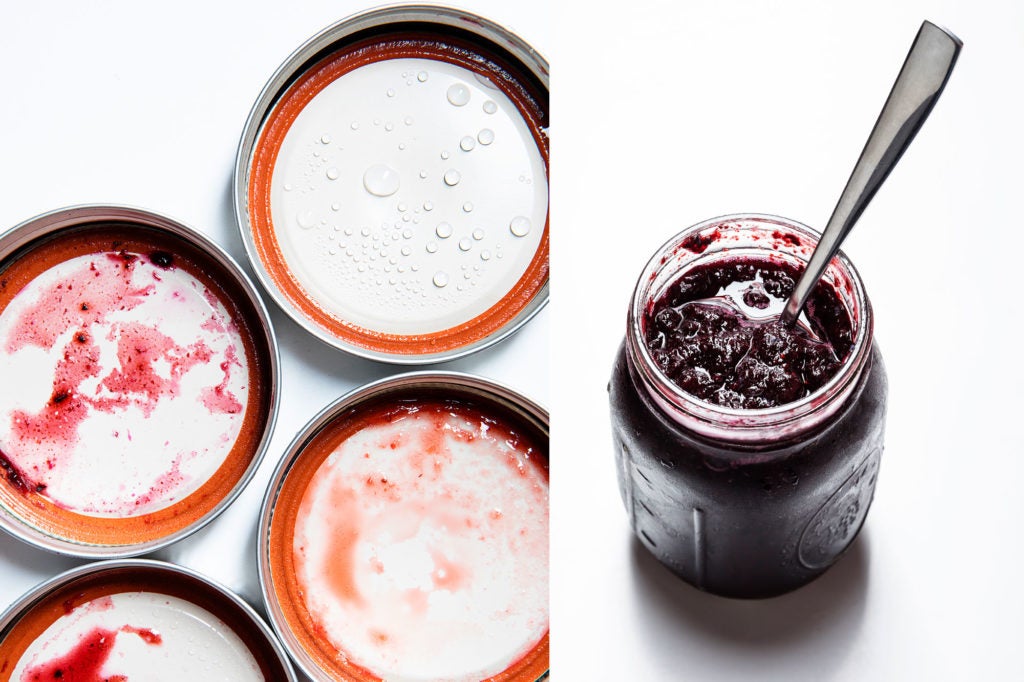
Bright banana, blueberry, and strawberry jams can be yours fast—no cooking required.
For as long as I can remember, I’ve been obsessed with the magical alchemy of preserving foods the old-fashioned way. Pickling, canning, dehydrating, candying, and fermenting. I love it all and have admittedly always looked down at modernity as a lazy cook’s crutch—something best left to amateurs without the pedigreed patience of a chef like, cough, myself. Thankfully, a six-pint pack of softening strawberries from the Union Square Greenmarket, and an impending trip out of town, helped change my mind. In a pinch, I macerated then froze the fruit and returned home to the most delicious jam I’ve ever tasted. And the experience sparked my latest late-summer cooking obsession, one that doesn’t get much love: freezer jam.
Here’s how it works. When we put fruits and vegetables in the freezer, the water inside freezes, expanding and exploding the delicate cell structure, leaving a mushy and mealy texture. For tomatoes or zucchini, this can be bad. But for jam, it’s a critical and beneficial step—breaking the cell structure allows the sugar, acid, and pectin to thoroughly saturate the fruit.
Traditionally, jam is cooked in order to break down the cells and mix the ingredients. Cooking has its merits, but it also changes the color and flavor profile, which can render it impossible to make decent jam from some of the subtler seedpods, like watermelon, cantaloupe, and bananas—which is why you never see these preserved on your supermarket shelf. And while making freezer jam isn’t completely foolproof, it’s relatively fast, doesn’t require any special equipment, and alleviates the food safety concerns accompanying pressure canning or jelly making.
The process for making freezer jam is simple: 1) Cut and mix your fruit with sugar until the sugar is completely dissolved. 2) Boil some pectin in water. 3) Mix the pectin with the macerated fruit. 4) Freeze overnight, thaw, and enjoy.
Using a calcium-activated, low-sugar pectin will help ensure proper jelling without the need for extra sugar. You can find this at most supermarkets, and it lasts indefinitely, so it’s worth stocking a box in your pantry. As with most simple recipes, ratio is key, and getting the perfect sweetness and consistency can take some trial and error. But following my tested and trusted formula should get you most of the way there, plus or minus a little extra sugar depending on the ripeness of your fruit.
How to Make Freezer Jam
You can mix your jam by hand, but it takes some serious elbow grease, so this recipe is a perfect opportunity to flex with your fancy food processor or stand mixer. Note that all packages of calcium-activated pectin include two packets: the pectin and the calcium. We’ve called out directions for integrating both, or you can revert to the instructions on the package if you like.
Ingredients
1 cup of chopped fruit
A pinch of sea salt
2/3 cup of sugar
¼ lemon or lime, juiced
1 teaspoon calcium [diluted in ¼ cup of water]
1 tablespoon of pectin
Directions
Combine your chopped fruit, salt, 1/3 cup of the sugar, lemon or lime juice, and 4 teaspoons of the diluted calcium solution in a food processor or stand mixer and pulse to incorporate, being careful not to completely puree the fruit. Let stand 10 minutes, pulsing momentarily every 2 minutes to help dissolve the sugar. In the meantime, whisk the remaining 1/3 cup of sugar, pectin, and 3/4 cups of water and bring to a boil and cook for 1 minute, whisking constantly. Pour the boiling pectin over the fruit and pulse to incorporate. Portion the jam into small jars or resealable bags, and freeze until ready to enjoy.
You can make freezer jam from just about any fruit, and there are tons of resources online, so I’ve omitted many of the more common recipes (except for strawberry) in favor of my favorite exotic combinations. Because the jam isn’t cooked, the natural flavor will shine through in the finished product—so the better the fruit, the better the outcome. Soft or overripe fruit works well, but if it’s begun to turn sour, you’re better off feeding it to the pigs.

But First, the Classic: Strawberry
I hate playing favorites, but when it comes to jam, I’m in agreement with the masses—strawberry is simply the best. And if you haven’t had strawberry freezer jam, then here’s where to start. Freezing locks in the fruit’s fresh flavor, giving you a burst of summer with every bite. To make: The freezer jam formula above was based on my strawberry recipe, so it should work great. Use lemon, and make sure not to overblend the berries—you’ll want some chunks for texture.
Banana Mango
Hear me out. There are folks who prefer straight banana flavors, and I like those folks. But bananas can be insanely sweet, so I love the addition of acidic mangoes to help balance the flavor. Adding a few drops of fresh vanilla enhances the tropical appeal if you have some on hand, and feel free to experiment with spices like ginger, nutmeg, and allspice if you want to channel some holiday cheer. To make: Follow my formula, but use half the sugar required to cut back on the sweetness. I prefer lime juice over lemon for this recipe.
Pineapple and Passion Fruit
If you’ve never bought fresh passion fruit before, then heed my advice: The lighter the orb, the better; old, dry, and wrinkly shells yield the sweetest fruit; plus, you purchase by the pound, so it pays to reach for the greatest volume by weight. To make: I love adding in the crunchy passion fruit seeds, but if you prefer the jam without, simply blend the fruit with a little orange juice or water, then strain to get all of the flavor minus the crunch. Four passion fruits per pound of pineapple is the perfect ratio. Follow my formula, but omit the lime and lemon, because passion fruit is adequately acidic on its own.
Blueberry Orange Marmalade
While making marmalade technically requires a separate technique altogether, the addition of boiled orange rind elevates this freezer recipe beyond your basic blueberry jam. To make: Use a peeler to remove the outermost layer from one whole orange, then slice into a fine julienne knife cut. Bring a small pot of water to a boil and cook the rind for one minute, then drain. Juice the orange and combine with the cooked rind and two pints of blueberries. Mix in your salt, sugar, lemon juice, and calcium, then combine with the cooked pectin, following my formula.
Cherry
Nothing compares to the fresh flavor of cherry freezer jam. Pitting the fruit can be tricky without the use of a specialty tool, but luckily they’re inexpensive, last forever, and can do double duty pitting olives in the off-season. To make: Follow my formula, using lemon rather than lime, and double the sugar called for, as cherries are deceptively sour.
Cantaloupe
Cantaloupe jam? Melons don’t cook well, making them a perfect candidate for freezer jam. And trust me, you’ll love the outcome. It’s perfect paired with ricotta, yogurt, or cottage cheese on toast. I like to pair fresh herbs with melon to add an extra layer of complexity—and mint or basil work exceptionally well here. To make: Add a quarter cup of roughly chopped basil leaves to the fruit and double the pectin called for in my formula, using lemon juice for the acid.